Matt Rees's Blog - Posts Tagged "naples"
What am I reading?
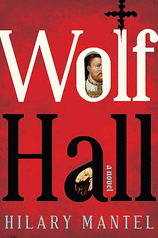 On the "Writers Read" blog, which is run by the indefatigable Marshal Zeringue, the latest post features my most recent reading. It's not what you might think -- in other words, it isn't detective fiction (well, there's one such book, sort of...) and it's not full of books about the Middle East. Have a look at the historical fiction, travel writing, and investigative nonfiction recently on my nightstand (that's just a turn of phrase -- I don't have a nightstand and I don't read in bed.) Read on for the rest of my post.
On the "Writers Read" blog, which is run by the indefatigable Marshal Zeringue, the latest post features my most recent reading. It's not what you might think -- in other words, it isn't detective fiction (well, there's one such book, sort of...) and it's not full of books about the Middle East. Have a look at the historical fiction, travel writing, and investigative nonfiction recently on my nightstand (that's just a turn of phrase -- I don't have a nightstand and I don't read in bed.) Read on for the rest of my post.Matt Beynon Rees has lived in Jerusalem since 1996. He covered the Middle East for over a decade for the Scotsman, then Newsweek, and from 2000 until 2006 as Time magazine's Jerusalem bureau chief. He published his first novel featuring Palestinian detective Omar Yussef, The Collaborator of Bethlehem, in 2007, which won the CWA John Creasey (New Blood) Dagger award. A Grave in Gaza and The Samaritan's Secret followed in 2008 and 2009. The new novel in the series, The Fourth Assassin, follows Omar to visit his son in New York's "Little Palestine" in Brooklyn.
A couple of weeks ago I asked Rees what he was reading. His reply:
Wolf Hall—Hillary Mantel
Simply the best historical novel for many, many years. Mantel’s portrayal of Tudor England, through the self-made politician and courtier Cromwell, is magnificent. It won the Booker Prize, which isn’t always such a recommendation. In many of the novels chosen for the prize, linguistic flash is chosen over characterization, leaving an emotional void for the reader. But in this case the prize committee got it right. Mantel’s characters breathe, even when they’re not central. One of the amazing things she pulls off in this book is to have a very broad range of characters who, without being central, manage to be rounded, returning here and there throughout the lengthy narrative with immediate life – they don’t need to be reintroduced; we already know who they are and how they think.
Nineteen Seventy-Four—David Peace
Peace’s “Red-Riding Quartet” (which includes other books also titled after the years in which they're set) is talked about as attempting to do for the UK in the ‘Seventies and ‘Eighties what James Ellroy has done for the US in the ‘Sixties. Namely to take the history we think we know and reveal the corrupt underside of it all. He’s successful in portraying the utter decay of Britain, revealing why voters were ready for the remaking of the entire country for which they voted in 1979 with the election of Margaret Thatcher. He doesn’t quite – at least in this first volume – manage to link the lower regions of society with those who rule. There's no equivalent of Ellroy's chats between his fictional agents and J. Edgar Hoover, for example. That connection is spelled out, rather than shown. Also his period scene-setting is a little heavier than Ellroy’s – hardly a page goes by without some archetypal song of the era playing in the background on the radio or a tv show all Brits would remember going with the sound down. The biggest success of the book is creating a “hero” who’s almost – but not quite – repulsive enough for us to half-believe that he’s the serial killer.
In the Shadow of Vesuvius—Jordan Lancaster
For lovers of Italy, and most surely for those who enjoy the madhouse that is modern Naples, this cultural history of the southern Italian city is an enjoyable way to learn that it was always that way. A Paradise inhabited by devils, or a Hell that’s home to angels, as Lancaster puts it. She deals with the complexity of Neapolitan politics – through rule by Rome, various Spanish, French and Norman dynasties, and the desperate straits into which the city was cast by Italian unification – with a light touch.
Gomorrah – Roberto Saviano
Can you tell I’ve been in Naples in the last month or two? This young Italian journalist named names in his account of the Camorra, Naples’s mafia. In return he got death threats and a life in hiding under police protection. It’s a marvelous tour of the underside of a town where only last year no one could agree on where to take the trash, so it all piled up in the streets, in mounds higher and longer than buses. When you visit Naples, as friends of mine there put it, you either hate the chaos or you love it. Either way, this book reveals just why it is that the city works – or fails to do so – as it does.
Published on February 04, 2010 16:45
•
Tags:
1974, blogs, camorra, crime-fiction, david-peace, gomorrah, hilary-mantel, historical-fiction, in-the-shadow-of-vesuvius, jordan-lancaster, naples, napoli, reading, red-riding, roberto-saviano, tudor-history, wolf-hall
On Caravaggio’s Trail: Travelling to Research A NAME IN BLOOD
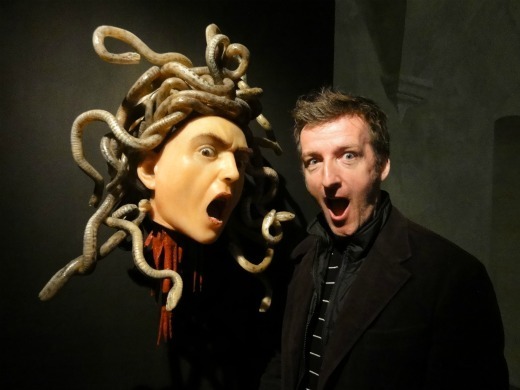
As I researched A Name in Blood, my novel of Caravaggio, I went all over Europe and North America, tracking Caravaggio's works and the places that touched his life. The period locations I visited gave me a flavour for Caravaggio’s life. In some cases, they gave me ideas for plot twists in the book.
Everywhere I found people fascinated with this most compelling of artists. On one of my sojourns in Rome, there was an exhibition devoted to Caravaggio's use of mirrors to project images (over which he painted, giving the vivid realistic feel people usually notice when they first see his work). He used his own head, probably in a convex mirror, to paint his "Medusa," which ended up in Florence at the Galleria Uffizi. The Rome exhibit made a nice mock up. Life size, as you see, though perhaps not as scary as a traveling author making a funny face.
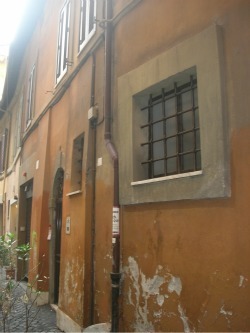
Caravaggio lived most of his time in Rome in the palaces of wealthy patrons. For a brief period, he rented this house (right) in a tiny street in Rome's historic center. Then he fell behind on the rent, lost the place, got drunk and went around to break his landlady's windows. I stood in the tiny alley imagining what it must have been like to be Madama Bruni, with a raging nutcase hurling rocks at her shutters from a yard away and bellowing that he was going to carve her up. Unfortunately I had to cut that incident out of A Name in Blood because, as with some other juicy moments in Caravaggio’s life, they were deeply revealing, but they didn’t drive my narrative forward.
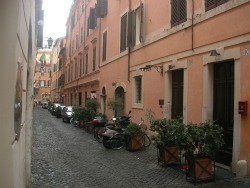
Caravaggio’s model (and, I think, lover) Lena lived here (left). In the Via dei Greci. In the heart of what used to be the Ortaccio, or Evil Garden, where only whores and the very poor lived. And artists, of course. Both places are now very expensive spots in the middle of Rome’s tourist area. But they're still redolent of C's time. At night, they're dark and empty. Though not spooky. I never get spooked in Rome. I’m too damned happy there.
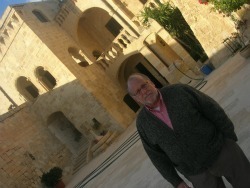
Rome was an important stop on my researches into period locations (as opposed to my more farflung journeys to the many galleries housing Caravaggio’s work), but Malta was in many ways the most compelling, because Caravaggio’s influence is still so considerable. Caravaggio is an important figure for its capital, Valletta, where he became a Knight of Malta and painted one of his masterpieces, The Beheading of Saint John for the city’s cathedral. Father John Critien (right) is the only Knight of Malta who currently lives in Castle Sant'Angelo on Valletta's harbor. C was imprisoned here, and made a dramatic escape. Father John and I spent a delightful afternoon examining all the spots where Caravaggio might've been held. Many think it was in a hole in the rock called the guva.
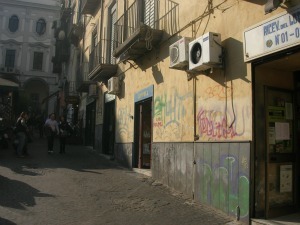
On to Naples I went. At left is the site of the Ceriglio Tavern, where Caravaggio was attacked on his way out. He got a scar, probably just to teach him a lesson rather than an attempt to kill him, and an injury to his eye, which can be seen in his last work, David with the Head of Goliath. I noticed that for much of the afternoon anyone leaving the Ceriglio and headed toward Caravaggio's digs at what’s now called the Palazzo Cellamare would be blinded by the sunlight. A good time for an attack.
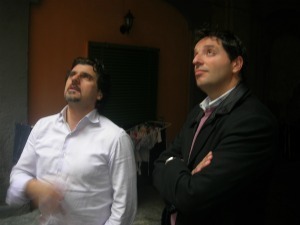
My friend Ugo Somma, far right, showed me around Naples. Here he is examining the chapel of the Knights with a fellow named Rosario who works for the Knights of Malta in Naples. At first Rosario wouldn't let us look around the Knights' church. But when I told him he looked like Caravaggio, he relented and even introduced me to his sister...
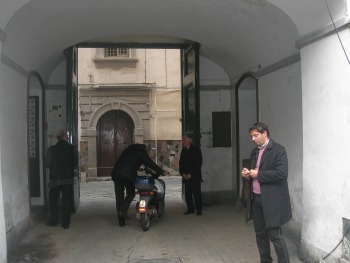
At the Knights' Priory in Naples, these fellows were hanging around in the courtyard looking like mafia capos waiting to rub someone out. A non-Neapolitan had been named that morning as the new Prior. They were, as the Italians say, "arrabiati." Mad as hell. Their sullen expressions and taciturn demeanor gave me an idea for a plot twist in A Name in Blood….
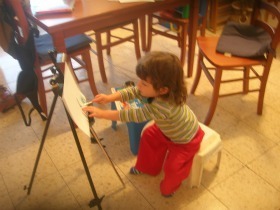
My son became an aficionado of Caravaggio as the research went on. He visited many of the galleries and churches in Rome where Caravaggio’s paintings hang. When I was painting my own versions of Caravaggio’s Madonnas, I told him the woman was named Mary. He decided we had to call his new sister by that name, which we did (in the Welsh fashion, it’s spelled Mari.) His name being Cai, we dubbed him Cairavaggio.
One of my earliest memories is of a schoolteacher who had been in Naples with the British army in World War II. He wasn’t talkative, but one day he told me about a hunchback who had beckoned him to a garden and shown him the most beautiful sight he had ever seen: the perfect view over the Bay of Naples. Somehow that simple recollection of beauty by an old man, unfolded in an uncomplicated way to a small boy, brings tears to my eyes. I found the same beauty in Naples—alongside considerable depravity, too. They say, "See Naples and die." Unfortunately for Caravaggio, that's how it worked out, quite literally. Naples is magical, lively, putrid and beautiful. From the Spanish Palace looking at San Francesco, here's one moment when I thought: Matt, you lucky fellow, isn't "research" great?
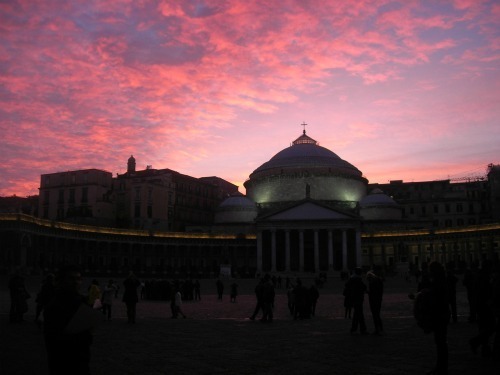
Published on June 06, 2012 04:10
•
Tags:
a-name-in-blood, art, art-history, caravaggio, crime-fiction, historical-fiction, malta, naples, rome
Too Many Drugs: Following Caravaggio in Malta for A NAME IN BLOOD
 I left Rome to continue my research for A Name in Blood, my Caravaggio novel which is released July 1 in the UK, in Malta. Caravaggio fled to the remote island off the coast of Africa and became (briefly) a member of the Knights of Malta. It was a strange trip for me, but the isolation and pure weirdness I felt there gave me important insights for the novel.
I left Rome to continue my research for A Name in Blood, my Caravaggio novel which is released July 1 in the UK, in Malta. Caravaggio fled to the remote island off the coast of Africa and became (briefly) a member of the Knights of Malta. It was a strange trip for me, but the isolation and pure weirdness I felt there gave me important insights for the novel.I spent December in Malta in a cheap hotel in a four-hundred-year-old building that was without heating and insulation, in a room where one of the windows didn’t close. I got sick. I took some drugs, staring across the harbor at the sheets of rain plummeting down on the Castel Sant’Angelo where Caravaggio was imprisoned for a time. It got damper in my room. I took too many drugs. I hallucinated, slept at unaccustomed hours and was awake when everyone else was in bed. I saw things that weren’t there. I drank far too many espressos at the Café Merisi, which takes Caravaggio’s family name and emblazons his face on the napkins, until I was as jittery as a June bug. A June bug with an overdose.
In this condition, I stood all day before The Beheading of Saint John, Caravaggio’s largest canvas and one of his most gruesome and disturbing. He showed John the Baptist collapsing, hands bound, on the floor of a dungeon, his executioner sawing his head away and a jailor gesturing for the severed head to be placed on a platter held by a young woman. It’s the only painting where Caravaggio signed his name. And he did it in a deep red, mingling with the blood spurting from the dying saint’s neck, giving me the title of my novel: A Name in Blood.
At night I wandered the narrow, deserted, windswept streets of Valletta’s Baroque center, weaving light-headed over the flagstones under the sad Christmas lights that rocked on the wind. Loudspeakers on the street lamps played cheesy carols. Alone as I was, I sang along, laughing to myself and feeling more than a little unhinged. In the alleys, I imagined Caravaggio here, knowing that men sought to kill him. I jogged giggling up the banks of steps that connect the streets along Valletta’s high ridges, as if I were fleeing. I panted in fear and slugged down some more drugs from the pocket of my raincoat and felt his horror of the dark.
I knew why Caravaggio had painted his figures emerging from the threatening shadows into a light so luminous that it glows straight through your skin and eyes and into the seat of your capacity for love, wherever that may be.
Stumbling down the steps toward my hotel above the gate where the Knights used to display the heads of Muslim pirates on spikes, I knew I was ready to write.
Published on June 07, 2012 01:15
•
Tags:
a-name-in-blood, art, art-history, caravaggio, crime-fiction, historical-fiction, malta, naples, research, rome



